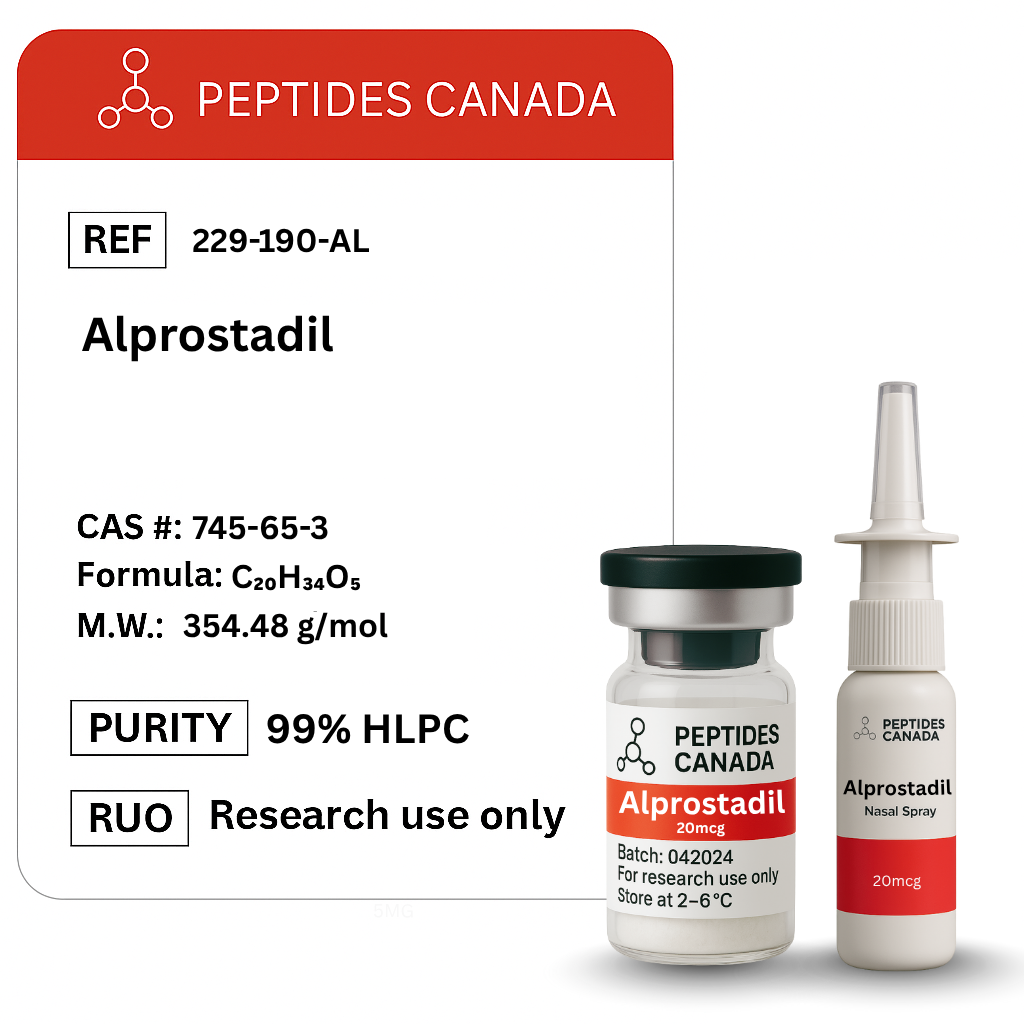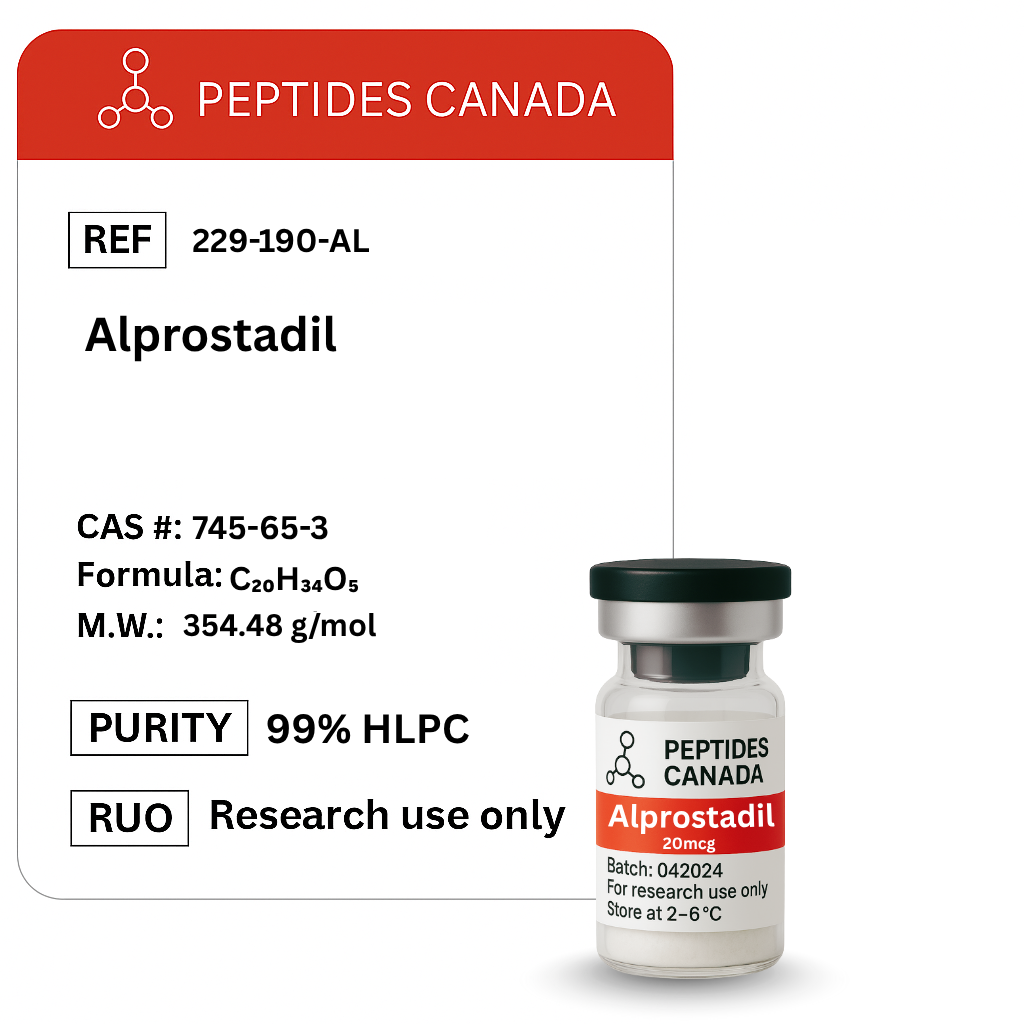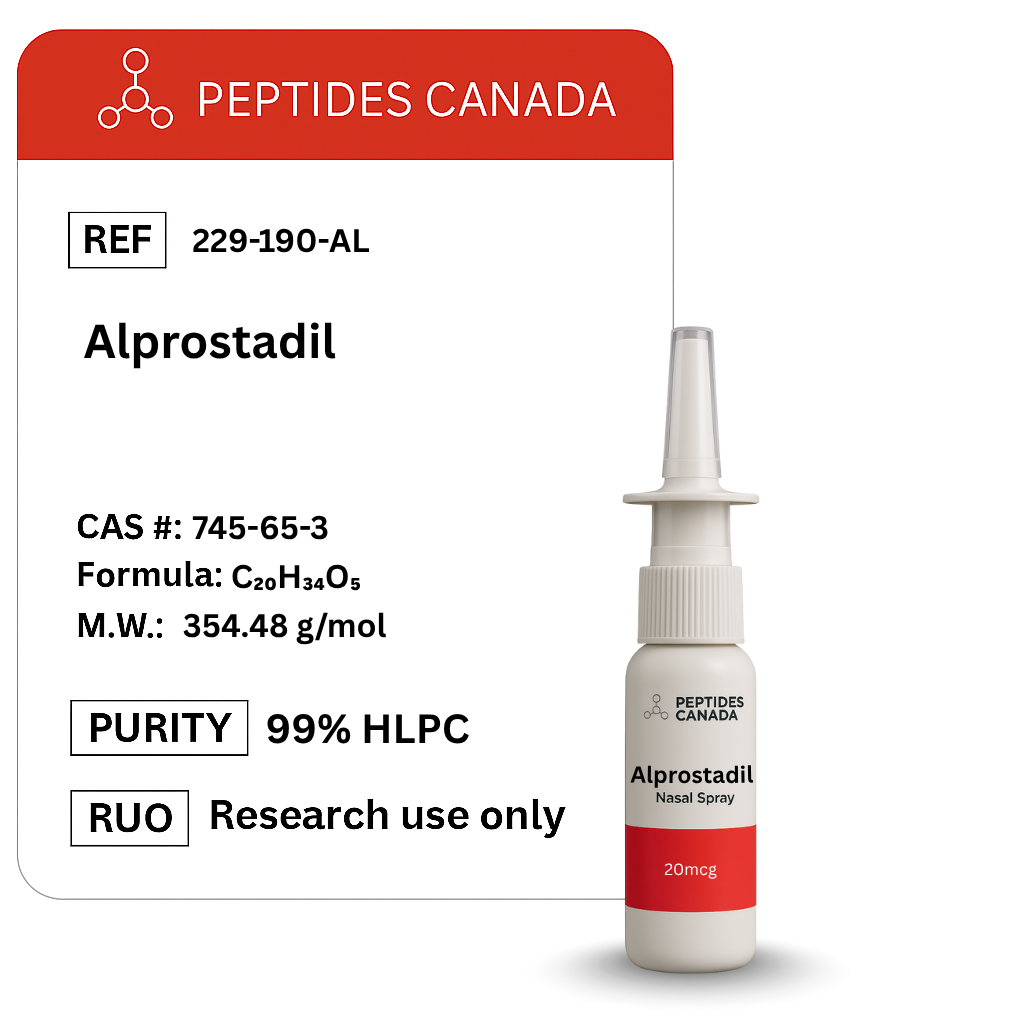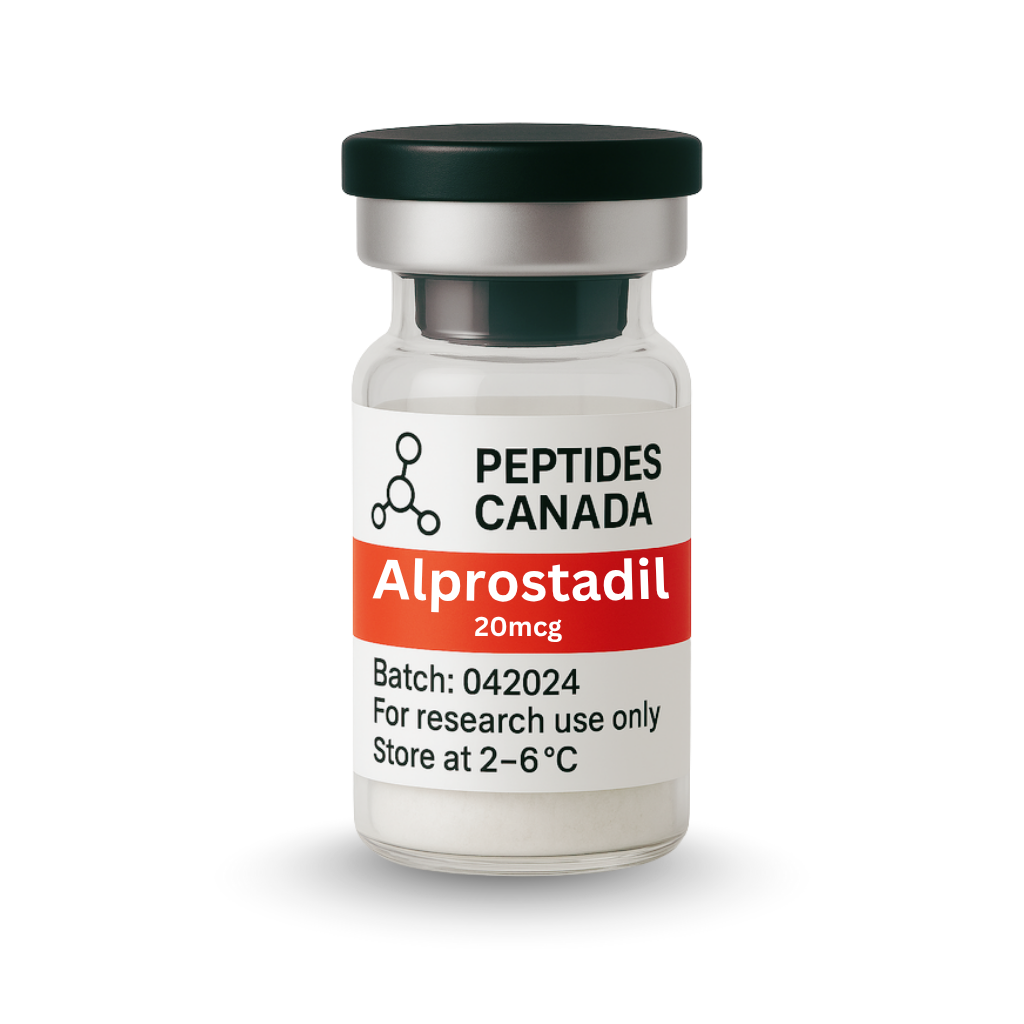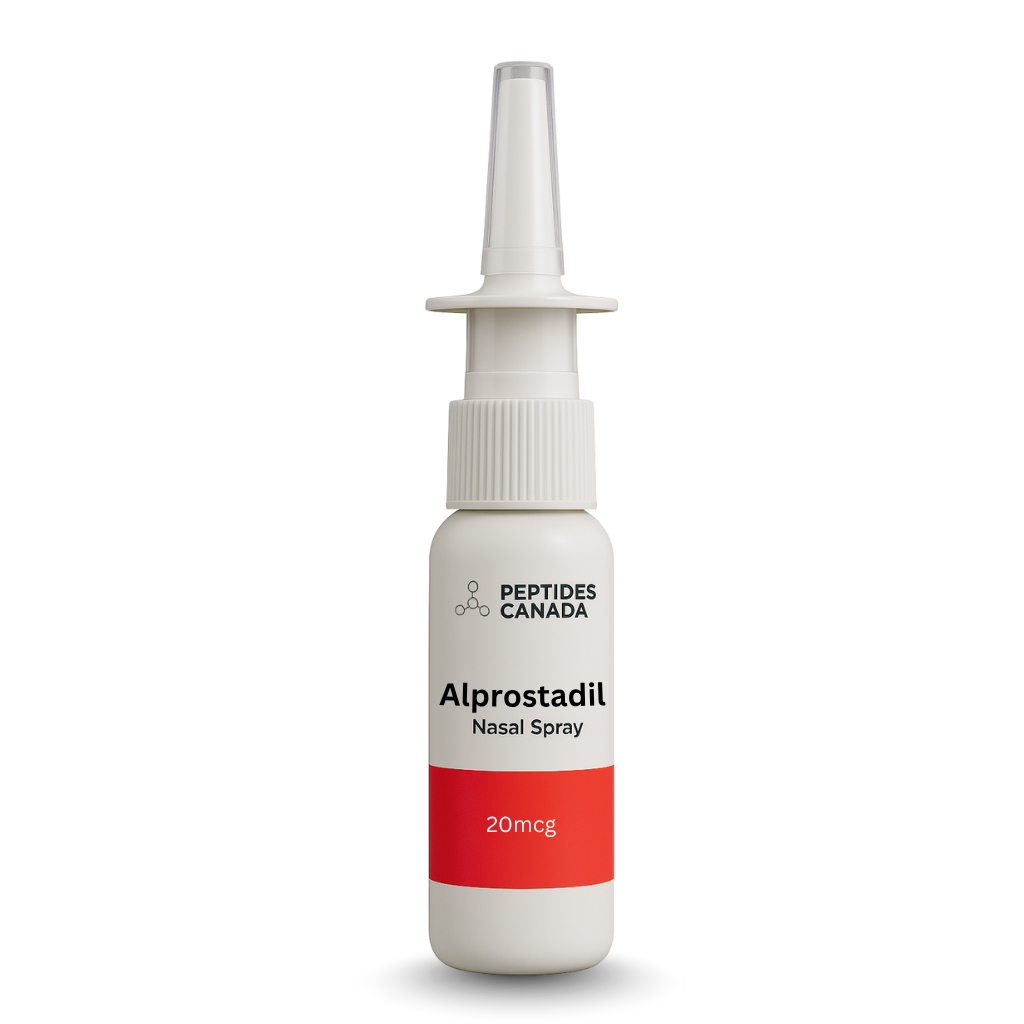Alprostadil
From CAD $163 CAD $181
Size: 20mcg
Contents: Alprostadil (Prostaglandin E1 Analog, Vasodilator)
Form: Powder
Purity: 99.3%
TESTED FOR:
- PURITY
- STERILITY
- WEIGHT
- ENDOTOXINS(LPS)
Free Reconstitution solution automatically added to your cart with each order of vial.
This product is Made, Tested & Shipped From Canada.
Ships Today
Order by 1:00 PM EST
Free Shipping
For 2 or more vials
99%+ Purity Guaranteed
COA Verified+
Trackable Shipping
Alprostadil
Alprostadil, also known as prostaglandin E₁ (PGE₁), is a naturally occurring prostanoid derived from arachidonic acid. It is a potent vasodilatory compound that acts through the prostaglandin E receptor (EP) subtypes, primarily EP₂ and EP₄, leading to smooth muscle relaxation and increased intracellular cyclic adenosine monophosphate (cAMP) levels. In biochemical research, Alprostadil serves as a well-characterized reference compound for studying vascular tone regulation, platelet aggregation, and cellular signaling cascades involving cAMP pathways.
Alprostadil is structurally defined as (11α,13E,15S)-11,15-dihydroxy-9-oxoprost-13-enoic acid, a 20-carbon lipid mediator with a cyclopentane ring core. Its configuration confers high receptor specificity and a short biological half-life, making it suitable for kinetic and mechanistic studies on prostanoid receptor signaling and second-messenger dynamics.
Overview
Alprostadil has been widely utilized in experimental models to examine endothelium-dependent vasodilation and microcirculatory flow. Through activation of EP receptors, it triggers adenylate cyclase, which catalyzes the conversion of ATP into cAMP. The elevated cAMP concentration subsequently activates protein kinase A (PKA), resulting in phosphorylation of myosin light-chain kinase and subsequent smooth muscle relaxation. This mechanism has been applied in research investigating vascular disorders, tissue perfusion, and ischemia-related cellular metabolism.
In platelet physiology, Alprostadil inhibits aggregation by blocking thromboxane A₂-mediated signaling, providing a reliable model for assessing anti-thrombotic and endothelial protection pathways. In cellular studies, it has been shown to modulate calcium influx, mitochondrial respiration, and inflammatory mediator expression, allowing it to serve as a pharmacological probe in cardiovascular and inflammation research.
Chemical Makeup
- Molecular Formula: C₂₀H₃₄O₅
- Molecular Weight: 354.48 g/mol
- Other Known Titles: Prostaglandin E₁; (11α,13E,15S)-11,15-dihydroxy-9-oxoprost-13-enoic acid
Analytical characterization confirms the expected mass of 354.48 Da, consistent with the theoretical molecular weight for Alprostadil. Research-grade preparations are typically verified by HPLC purity testing to ≥ 98 % and validated through LC-MS for molecular identity, ensuring suitability for receptor-binding, biochemical, and mechanistic assay applications.
Research and Experimental Studies
Alprostadil and Vascular Dynamics
Experimental studies have demonstrated that Alprostadil induces concentration-dependent vasodilation in arterial and microvascular models. By elevating cAMP and activating PKA, Alprostadil reduces intracellular calcium, leading to vascular smooth muscle relaxation. Its effect has been used to elucidate EP receptor sub-type contributions to endothelial signaling.
Alprostadil and Platelet Aggregation
In in-vitro platelet aggregation assays, Alprostadil has been shown to inhibit ADP- and collagen-induced aggregation through cAMP-dependent mechanisms. This makes it a standard reference agent for studies exploring cyclic nucleotide modulation in thrombosis and platelet biochemistry.
Alprostadil and Tissue Protection Models
Alprostadil has been evaluated in cellular and organ models of ischemia and reperfusion. Experimental data suggest it can attenuate oxidative stress, reduce intracellular calcium overload, and modulate mitochondrial permeability transition, thereby supporting its use as a research tool for cytoprotective and anti-inflammatory pathway investigation.
Alprostadil and Receptor Signaling Pathways
Research utilizing radioligand binding and gene expression analysis indicates that Alprostadil selectively interacts with EP₂ and EP₄ receptors, leading to downstream activation of adenylate cyclase and PKA pathways. This receptor selectivity provides a platform for mapping EP receptor signaling and for assessing the pharmacological actions of novel prostanoid analogs.
Alprostadil is supplied for research and laboratory use only. Not for human or veterinary application.
References
- Coleman RA, Kennedy I, Humphrey PP, Bunce K, Lumley P. Prostanoids and their receptors. Pharmacol Rev. 1994;46(2):205-229. https://pubmed.ncbi.nlm.nih.gov/7938168/
- Narumiya S, Sugimoto Y, Ushikubi F. Prostanoid receptors: structures, properties, and functions. Physiol Rev. 1999;79(4):1193-1226. https://pubmed.ncbi.nlm.nih.gov/10508233/
- Regan JW. EP receptor subtypes and signaling. Annu Rev Physiol. 2003;65:357-384. https://pubmed.ncbi.nlm.nih.gov/12471165/
- Moncada S, Vane JR. Prostacyclin and prostaglandin E in vascular control. Pharmacol Rev. 1979;30(3):293-331. https://pubmed.ncbi.nlm.nih.gov/37109/
- Watanabe K, et al. Biosynthesis and metabolism of prostaglandins. Prog Lipid Res. 1999;38(3):249-276. https://pubmed.ncbi.nlm.nih.gov/10523396/
- Seegers JC, Lotter MG, et al. The inhibitory effects of prostaglandin E₁ on human platelet aggregation. Thromb Res. 1978;12(6):987-995. https://pubmed.ncbi.nlm.nih.gov/356104/
- Miyamoto T, et al. Cyclic AMP signaling by prostaglandin E₁ in vascular smooth muscle. J Biol Chem. 1993;268(26):19840-19846. https://pubmed.ncbi.nlm.nih.gov/8396041/
- Kobayashi T, et al. EP₂ and EP₄ receptors mediate relaxation of vascular smooth muscle by PGE₁. Am J Physiol. 2004;287(5):H1896-H1903. https://pubmed.ncbi.nlm.nih.gov/15231505/
- Zhang YH, et al. Alprostadil attenuates ischemia/reperfusion-induced injury via cAMP/PKA pathway. Biochem Pharmacol. 2012;84(6):751-760. https://pubmed.ncbi.nlm.nih.gov/22813991/
- Xu Z, et al. Protective effect of prostaglandin E₁ on endothelial cells under hypoxic conditions. J Cardiovasc Pharmacol. 2011;58(4):385-392. https://pubmed.ncbi.nlm.nih.gov/21747204/
- Kanda T, et al. Alprostadil as a cAMP-dependent modulator in ischemic models. Cardiovasc Drug Rev. 2003;21(2):115-126. https://pubmed.ncbi.nlm.nih.gov/12956792/
- Sugimoto Y, Narumiya S. Prostaglandin E receptors. J Biol Chem. 2007;282(16):11613-11617. https://pubmed.ncbi.nlm.nih.gov/17329241/
- Chen Y, et al. Alprostadil protects mitochondria from oxidative stress via EP₄-PKA signaling. Free Radic Biol Med. 2018;121:202-211. https://pubmed.ncbi.nlm.nih.gov/29229565/
- ClinicalTrials.gov. Study of prostaglandin E₁ analogs in microcirculation. https://clinicaltrials.gov/ct2/show/NCT01981310
- National Center for Biotechnology Information. PubChem Compound Summary for CID 5280723, Alprostadil. https://pubchem.ncbi.nlm.nih.gov/compound/Alprostadil
For Research Use Only. Not for human or veterinary use.
HIGHEST QUALITY PEPTIDES
Our products are scientifically formulated and manufactured in cGMP-compliant facilities.
FAST DELIVERY
Enjoy fast and reliable 3–5 day shipping.
Dedicated Customer Service
Our customer service team is highly knowledgeable in peptide research and its applications. We’re available 24/7 to assist you.
Tested. Verified. Trusted.
We take a laboratory-first approach to quality. Each batch is made under controlled conditions and verified by an independent lab (HPLC/MS). We only ship batches that test ≥99% purity, and we provide a full COA, including identity, methods, and chromatograms, for your review.
See the Process for Yourself
We make our peptides in our own cGMP lab. Watch the video to see how every vial is produced, tested, and handled with care.
Science Behind Our Peptides
A clear explanation of how our peptides work, their benefits, why quality matters for best results, and what you should know.
Categories
Categories
How do I know the peptides I order are exactly what the label says?
Every vial we sell comes from a lab that follows current Good Manufacturing Practices (cGMP). That means each step of production is documented and controlled. Before a batch is released, it’s tested by independent third-party labs for purity, identity, and sterility. Certificates of analysis are available so you can see the exact test results.
Are your peptides produced in a sterile and controlled environment?
Yes. The labs we work with use ISO-certified clean rooms where air quality, equipment, and handling procedures are tightly regulated. Staff are trained to pharmaceutical-grade standards. This ensures the peptides are produced in an environment that minimizes contamination risks.
What about shipping? Do the peptides remain stable in transit?
Peptides in lyophilized (freeze-dried) form are stable at room temperature for transport. Once you receive them, refrigeration is recommended to maintain long-term integrity. We package every order securely to prevent damage and ship promptly, so your vials arrive in optimal condition.
How do I know you actually make these peptides yourselves?
We operate under strict in-house protocols that follow current Good Manufacturing Practices (cGMP). That means our team oversees the entire process from sourcing raw amino acids to the final lyophilized vial. Nothing is outsourced or repackaged. This gives us full control over purity, consistency, and sterility, and it’s why we can stand behind every single vial we ship.
What should I do with the vials once they arrive?
Store them in the refrigerator, away from direct light and heat. If you need to keep them longer, some peptides can be stored frozen. Each vial comes with clear handling instructions so you know the proper conditions for stability.
What proof do you have that your peptides are legitimate?
The strongest proof is transparency. For every peptide, we can provide certificates of analysis, manufacturing documentation, and references to the published scientific research behind it. If you ever have questions, we’ll show you the data rather than ask you to take our word for it.
